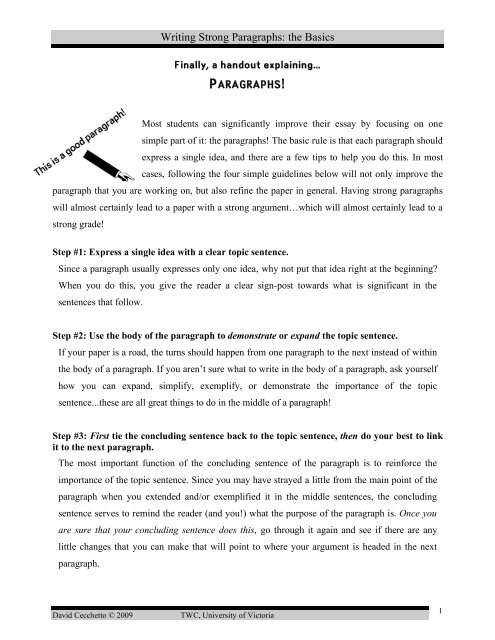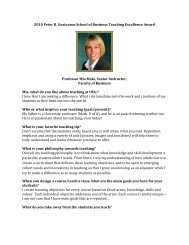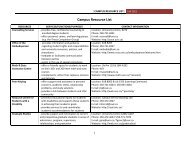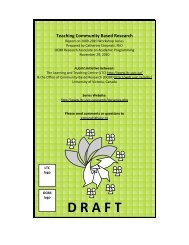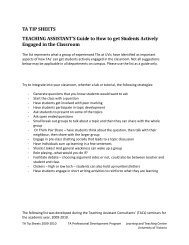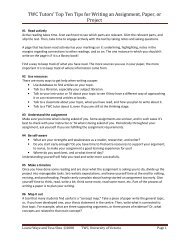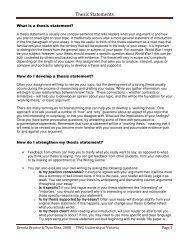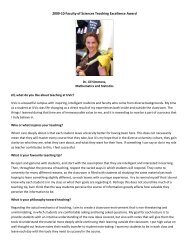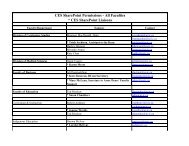Writing Strong Paragraphs: the Basics - University of Victoria
Writing Strong Paragraphs: the Basics - University of Victoria
Writing Strong Paragraphs: the Basics - University of Victoria
Create successful ePaper yourself
Turn your PDF publications into a flip-book with our unique Google optimized e-Paper software.
<strong>Writing</strong> <strong>Strong</strong> <strong>Paragraphs</strong>: <strong>the</strong> <strong>Basics</strong>Finally, a h andout explaining…P ARAGRAPHS!Most students can significantly improve <strong>the</strong>ir essay by focusing on onesimple part <strong>of</strong> it: <strong>the</strong> paragraphs! The basic rule is that each paragraph shouldexpress a single idea, and <strong>the</strong>re are a few tips to help you do this. In mostcases, following <strong>the</strong> four simple guidelines below will not only improve <strong>the</strong>paragraph that you are working on, but also refine <strong>the</strong> paper in general. Having strong paragraphswill almost certainly lead to a paper with a strong argument…which will almost certainly lead to astrong grade!Step #1: Express a single idea with a clear topic sentence.Since a paragraph usually expresses only one idea, why not put that idea right at <strong>the</strong> beginning?When you do this, you give <strong>the</strong> reader a clear sign-post towards what is significant in <strong>the</strong>sentences that follow.Step #2: Use <strong>the</strong> body <strong>of</strong> <strong>the</strong> paragraph to demonstrate or expand <strong>the</strong> topic sentence.If your paper is a road, <strong>the</strong> turns should happen from one paragraph to <strong>the</strong> next instead <strong>of</strong> within<strong>the</strong> body <strong>of</strong> a paragraph. If you aren’t sure what to write in <strong>the</strong> body <strong>of</strong> a paragraph, ask yourselfhow you can expand, simplify, exemplify, or demonstrate <strong>the</strong> importance <strong>of</strong> <strong>the</strong> topicsentence...<strong>the</strong>se are all great things to do in <strong>the</strong> middle <strong>of</strong> a paragraph!Step #3: First tie <strong>the</strong> concluding sentence back to <strong>the</strong> topic sentence, <strong>the</strong>n do your best to linkit to <strong>the</strong> next paragraph.The most important function <strong>of</strong> <strong>the</strong> concluding sentence <strong>of</strong> <strong>the</strong> paragraph is to reinforce <strong>the</strong>importance <strong>of</strong> <strong>the</strong> topic sentence. Since you may have strayed a little from <strong>the</strong> main point <strong>of</strong> <strong>the</strong>paragraph when you extended and/or exemplified it in <strong>the</strong> middle sentences, <strong>the</strong> concludingsentence serves to remind <strong>the</strong> reader (and you!) what <strong>the</strong> purpose <strong>of</strong> <strong>the</strong> paragraph is. Once youare sure that your concluding sentence does this, go through it again and see if <strong>the</strong>re are anylittle changes that you can make that will point to where your argument is headed in <strong>the</strong> nextparagraph.David Cecchetto © 2009TWC, <strong>University</strong> <strong>of</strong> <strong>Victoria</strong>1
<strong>Writing</strong> <strong>Strong</strong> <strong>Paragraphs</strong>: <strong>the</strong> <strong>Basics</strong>Step #4: Check your work by going through your entire paper and reading only <strong>the</strong> first andlast sentence <strong>of</strong> every paragraph.If you have acted on <strong>the</strong> first three tips, you should be able to understand your paper by readingonly <strong>the</strong> first and last sentence <strong>of</strong> every paragraph. Even better, you should be able to read <strong>the</strong>first and last sentences to a friend and have <strong>the</strong>m understand what you are arguing. The reality is,when pr<strong>of</strong>essors have large numbers <strong>of</strong> papers to mark this is what <strong>the</strong>y sometimes do (not onpurpose, <strong>of</strong> course); if it doesn’t make sense to you, it won’t make sense to <strong>the</strong>m!For e xa mpl e:(1) Often, writing out a couple <strong>of</strong> well-structuredparagraphs when you are in <strong>the</strong> beginning stages <strong>of</strong> yourpaper can help you to craft <strong>the</strong> type <strong>of</strong> argument that youwant: subtle, coherent, and directed towards a logicalcompletion. (2A) Having well-crafted paragraphs is likehaving exact change for bus fare: it isn’t completelynecessary, but if you don’t have it you end up paying morethan you need to! (2B) In any case, you have to know whatyou have before can you know what you need, andcapturing an idea in a superb paragraph is <strong>the</strong> best way t<strong>of</strong>igure that out. (3 & 4) If you write a paper that follows allfour <strong>of</strong> <strong>the</strong> guidelines above, you’ll be taking <strong>the</strong> bus homefrom <strong>the</strong> library in time for dinner instead <strong>of</strong> at 1 AM…andwith a great paper in your hands!(1) A topic sentence, expressinga clear idea.(2A) The first sentence <strong>of</strong> <strong>the</strong>paragraph’s body exemplifies <strong>the</strong>topic sentence by using a simile.(2B) The second sentence <strong>of</strong> <strong>the</strong>paragraph’s body demonstrateswhy <strong>the</strong> topic sentence isimportant.(3 & 4) The concluding sentencere-states <strong>the</strong> topic sentence. Noticethat <strong>the</strong> paragraph makes senseeven if you only read <strong>the</strong> first andlast sentence.David Cecchetto © 2009TWC, <strong>University</strong> <strong>of</strong> <strong>Victoria</strong>2


